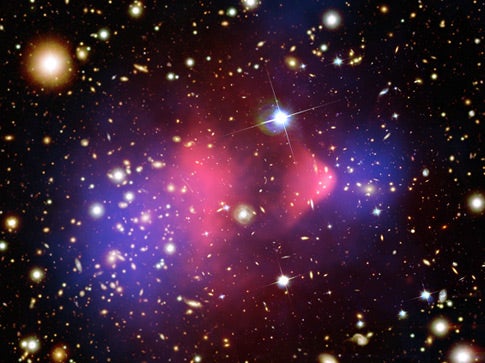The laws of gravity dictate how large-scale bodies, such as galaxies and galactic clusters, should interact. But for several decades, astrophysicists have realized a hidden agent is acting upon the cosmos. Scientists believe the universe must contain up to 5 times more “dark matter” than the ordinary matter seen in planets, stars, galaxies, and clusters. Now, Douglas Clowe of the University of Arizona and his colleagues report the first direct evidence of dark matter.
The cosmic smoking gun was found in the constellation Carina, at the site of two colliding galaxy clusters known as the Bullet cluster (galaxy cluster 1E 0657-56). Observers imaged the aftermath of the massive collision, which occurred 100 million years ago, in both visible and X-ray wavelengths. Galaxies in the system are passing through each other at 10 million mph (16 million kilometers per hour), leaving behind a wake of glowing gases.
Galaxy clusters typically contain 10 times as much mass in gas as in stars. As galaxy clusters pass through each other — stars are far enough apart that any actual collision seldom occurs — each cluster drags gas from the other, slowing the gas and leaving a wake. In the case of the Bullet cluster, the wake is rounded, or bullet-shaped. Detailed analysis revealed the system’s gravity is warping space and causing light from distant objects to bend around it in a phenomenon called gravitational lensing.
But the gravitational lensing is most pronounced outside of the gas, in regions on either side of the collision. Researchers believe dark matter is responsible. Gravity pulls the normal matter making up the clusters’ gases toward the system’s center. Any dark matter, however, would pass directly through the system, much as stars do. “We see that the mass, which is dominated by dark matter, is centered on the galaxies,” says team member Dennis Zaritsky of the University of Arizona. “Therefore, we infer that the dark matter has passed through the collision unaffected as well.”
If the team is right, Carina’s colliding galaxies have provided a key piece in our understanding of the fundamental workings of the universe. Says Zaritsky: “The significance to me is that it eliminates a nagging worry that we were ignoring a potentially very interesting alternative.” That alternative, namely, is that we don’t understand the fundamental laws of gravity. Now that astronomers have proof of dark matter’s existence, the next step is to sort out what the mystery matter is. The team’s results will appear in a forthcoming issue of Astrophysical Journal Letters.










